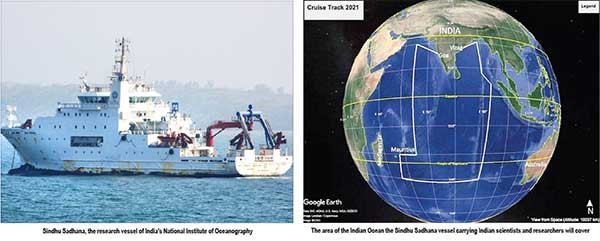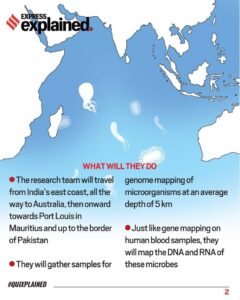Blog
Editorials
Daily Editorials
Editorials In-Depth, 05 Aug
Genome Mapping in the Indian Ocean.
General Studies- III (Awareness in the fields of bio-technology)
BY Chrome Ias
Share
Trending
Latest Courses
National Institute of Oceanography (NIO) has started a research project to reveal the internal working of the body of the ocean at a cellular level.
- For this, a 30-member team of scientists and researchers from the NIO in Panaji and another 30 crew members onboard its research vessel Sindhu Sadhana will spend the next three months traversing the course of over 10,000 nautical miles in the Indian Ocean.
- The first-of-its-kind research project in the country is aimed at understanding the biochemistry and the response of the ocean to climate change, nutrient stress and increasing pollution.

Objective:
One of the key objectives of this mission is to identify and characterise the genes and proteins in the ocean to understand the cellular level operation in the ocean.
How will the study help?
It will identify:
- The stress factors that control the changes in RNA and DNA in ocean microbes,
- How they are respond to a lack or excess of minerals and metals present in water, and
- What the impact is on climate change and food cycle.
Ocean genome will enable commercial biotechnology applications, from anticancer treatments and industrial enzymes to antiviral molecules.
Benefits:
- It will help scientists understand the internal working of the ecosystem of the Indian Ocean.
- The research will enable scientists to identify the factors controlling the changes in RNA, DNA in the oceans, and various stressors impacting them.
- It will help in identifying Mineral Concentration as ocean has several micronutrients like nitrates, sulphates and silicates, minerals like iron ore and zinc, and trace metals like cadmium or copper.
- Genome mapping will show the presence of which these microbes have adapted to atmospheric carbon dioxide.
- The large pool of RNA, DNA library of the oceans will be utilised for using the Indian Ocean to human benefit in the future.
What is the Genome Mapping?
Genome refers to an organism’s complete set of DNA, which includes all its genes and mapping these genes simply means finding out the location of these genes in a chromosome.
- Genome mapping is an important tool for locating a specific gene to a particular region of a chromosome.
- It also determine its relative distances between genes and molecular markers on the chromosome.
- There are two types of genome mapping approaches physical mapping and genetic linkage mapping, in which distances are measured in base pairs and recombination frequency, respectively.
Genome India Project:
The Genome India Project, which has been described as the “first scratching of the surface of the vast genetic diversity of India”.
It has involved over 20 scientists from institutions including the Indian Institute of Science (IISc) in Bengaluru and a few IITs.
Genes structure in Humans:
According to the Human Genome Project, there are estimated to be over 20,500 human genes.
- In humans, each cell consists of 23 pairs of chromosomes for a total of 46 chromosomes, which means that for 23 pairs of chromosomes in each cell.
- There are roughly 20,500 genes located on them.
- Some of the genes are lined up in a row on each chromosome, while others are lined up quite close to one another and this arrangement might affect the way they are inherited.
For example, if the genes are placed sufficiently close together, there is a probability that they get inherited as a pair.
Significance:
- Genome mapping enables scientists to gather evidence if a disease transmitted from the parent to the child is linked to one or more genes.
- Furthermore, mapping also helps in determining the particular chromosome which contains that gene and the location of that gene in the chromosome.
Genome mapping use in medicine:
- According to the National Human Genome Research Institute (NHGRI), genome maps have been used to find out genes that are responsible for relatively rare, single-gene inherited disorders such as cystic fibrosis and Duchenne muscular dystrophy.
- Genetic maps may also point out scientists to the genes that play a role in more common disorders and diseases such as asthma, cancer and heart disease among others.
National Institute of Oceanography (NIO)
The NIO is one of the 37 constituent laboratories of the Council of Scientific & Industrial Research (CSIR), New Delhi.
- Its headquarter is at Dona Paula, Goa, and regional centres at Kochi, Mumbai and Visakhapatnam,
- CSIR-NIO was established on 1 January 1966 following the International Indian Ocean Expedition (IIOE) in the 1960s.
- The institute has since grown into a multi-disciplinary oceanographic research institute of international repute.
Source: Indian Express
BY Chrome Ias
Trending
Latest Courses
For Daily Updates
Sign up for daily emails to get the latest Chrome IAS news.






